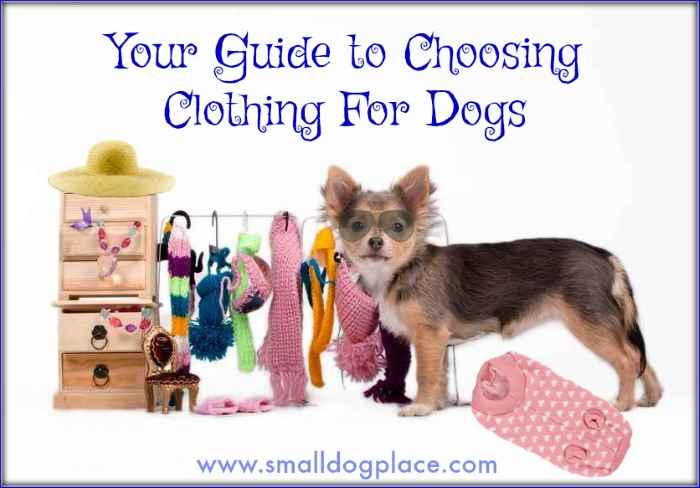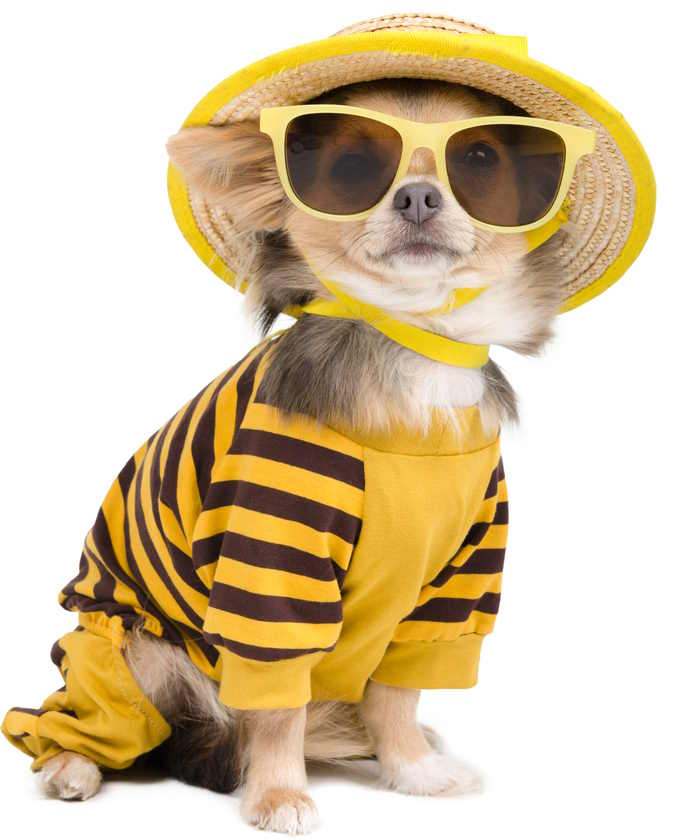- Small Dog Place Home
- Lifestyle
- Clothing for Dogs
The Ultimate Guide for Choosing Clothing for Dogs
Ultimate Guide for Choosing Clothing for Dogs, By Mackenzie Grove
Last Updated 04-07-2024
Do people really buy clothing for dogs?
The answer is a resounding YES, but what does the average small dog need in the way of outfits?
If you are planning to make your dog the next Instagram star, then you'll want to plan a full wardrobe of cute and stylish clothes.
Even if you just want to dress up your dog, there is a right and wrong way to go about choosing chic and fashionable clothing for a dog.

Even if you are a fashionista yourself, you might also worry about the safety and comfort of your dog. Well, not to worry anymore, because clothing for dogs is not a new trend and people have always found a solution to this problem.
In earlier days, people dressed dogs for various reasons such as in the case of war dogs and sled dogs.
Ancient armies would adorn their dogs in protective armor before going into battle. Ancient peoples would protect their sled dogs with outer garments and paw protection from icy, frigid weather.
Nowadays people dress up dogs for styling, comfort, and safety. We know a lot more now about choosing the right clothes for dogs.
Why Dress Up Your Dog?

Beyond the cute dresses, the silly costumes, or the heavy winter coats, there are many reasons why you might want to add to your little dog’s wardrobe.
After all, you’ve seen those photos of celebrities with their dogs decked out in fashionable, trendy clothes. How hard could choosing clothing for dogs really be?
Most dogs, especially those with very thick coats don’t really need much extra clothing. They have their own layering system.
For example, a double coated breed such as a Shih Tzu has a thick, soft, warm under coat and a long silky outer coat that can protect them in colder climates.
Terriers, such as a Cairn Terrier also have a thick wiry outer coat that sheds water and allows them to be outdoors even if wet damp weather and still feel dry and comfortable.
But some dogs do need extra protection. Many small breed dogs have one layer of hair. Although it might grow to be floor length as is the case with a Maltese, the soft, fine hair itself does not protect the dog in cold temperatures.
Let us not forget those hairless breeds such as the American Hairless, Chinese Crested or the Mexican Hairless. They might do fine in the tropics, but in a more temperate climate, they would feel the cold in the same way as you or I would.
Clothing for dogs can be essential for the comfort of pet dogs for many reasons. Here are just a few of the many reasons that some type of clothing may be necessary for man's best friend.
Climate
Rain, snow or extreme temperatures can be harmful and extremely uncomfortable to our pets. To protect them, some form of clothing is a must.
Dog Clothing works like an additional protective cover to help them feel content and enjoy themselves outdoors even in a snowstorm.
Allergies
Some people have allergies to dog dander and sneeze when that loose hair begins to fly around the house landing on you, your furniture, and your floor.
Clothing can reduce the amount of loose hair and help contain the dander. AND, if you are an allergy sufferer, it means you are likely to breathe easier.
A light weight doggie t-shirt or dress cannot eliminate shedding and dander, but it can make your life much easier.
Insects
Your dog can be bitten by insects, ticks, and fleas. In some cases, stings from bees, wasps, or hornets can be life threatening to a small dog.
Fleas are a major nusience that most dog owners hate. Ticks carry disease. Most dog owners want to protect their little dogs, and clothing can help.
Clothing will not stop a swarm of angry wasps, but it will be much harder for them to bite and sting if they must first penetrate a layer of clothing.
Factors to Consider When Choosing the Right Clothing for Dogs
Who doesn't want comfort? Everyone does. If I had to guess, most people not only choose their own clothing for style, but also for comfort.
Dogs are no exception.
A comfortable piece of clothing for your dog should not only look great but fit well. The choice of fabrics is also important to ensure comfort for your dog.
Choosing the right clothes that fit well and are constructed with comfortable fabrics will go a long way towards assuring your dog will keep the article on and feel comfortable doing so.

You may be tempted to go into a fancy boutique and choose an item that appeals to you, assuming your dog will look great in it.
Yes, your dog may look great and appearance is important, but it is even more critical that you choose something that will also feel good.
Here are few factors that you need to consider when buying clothes for your dog.
Dimension and Sizing of the Clothes

Clothing should not limit the dog’s physical movements. So, proper fitting is necessary. Different breeds are of various sizes and weights.
Their measurements are also different. Even within breeds, there is much variation, so you can not always go by a label that reads, “Perfect for Chihuahuas and other small dogs.”
For example, the clothing of small breeds like Chihuahua, or Yorkshire Terrier that may only weight a few pounds will also have little neck and back sizes.
A standard toy poodle may have a neck of 5.5", back 7" and chest 12." But your dog’s dimensions may be different, so it is always best to measure your dog before you begin your search for the perfect piece of clothing.
Any Clothing for Dogs Should Never Impede Urination
Who would want an item of clothing that is made in such a way that the dog either urinates or defecates on it? Not only is it uncomfortable for the dog, smelly, but it is going to add to your laundry bill.
In the case of male dogs, look for clothes with a higher cutout around the belly and the groin area. These types of clothes will prevent the dog from urinating on them.
Choose Clothing for Dogs that is Suitable for the Weather and the Environment
Clothing for dogs should be right for the environment and weather. Dogs only have sweat glands on the bottom of their pads so they can overheat in the hot weather. Don’t put on any warm clothing in the hot weather even if it looks cute.
In the colder winter months, there is often confusion as to whether dogs need a sweater, coat or none at all.
In deciding whether your dog needs extra protection in the winter, let his hair be the deciding factor.
If the dog has a thin coat of hair, you should provide warm clothes when going outside.
The breeds with thick hair do not need sweaters that much. But if the dog is weak or sick, he should wear a jacket in cold weather. Hoodies, coats, or sweaters can also be a good option. Puppies and older dogs may need a little extra protection too.
Whether the dog has thick hair or not, if the weather is dangerously cold, keeping him inside is a good idea. Dogs, like people, are very susceptible to hypothermia and frostbite.
Clothing For Dogs: Choose Fabrics Wisely
While wearing any form of clothing, the dog will still need to move, walk, run or play.
If the material becomes a hindrance to the mobility of your dog, then the purpose of clothes is not fulfilled. Stretchy materials make movement easier. Examples of such materials are cotton and spandex. So, choose the materials wisely.
Special attention should be given to wool.
Sometimes yarns made with real wool can feel itchy, and you will most likely need to hand wash rather than throwing them in with your regular laundry.
To avoid this problem choose a synthetic fabric or a mixture of cotton and washable wool.
Again keep in mind that, thinner more breathable fabrics such as a mesh can be a good option for ultimate comfort.
Colors, Looks, and Design
Now comes the time to make your dog a wee bit cuter. Different occasions call for different styles.
If it’s Halloween, dress him as sweet pumpkin. At Thanksgiving, dresses him as turkey. There are many options for the Christmas holidays including cute Santa outfits or delightful elf costumes.
You can do everything as long as you keep the comfort factors in mind.
What about color? Maybe not a big concern for dogs, but it means a great deal for people.
As the dog doesn’t have the ability to choose what clothes and colors will best suit his needs, it is up to you, the doggie parent to make those choices.
Choose the color which you think is best. If in doubt, do as most people do and pick black because it matches everything. You have other color options as well, such as tan, white or blue. Make a choice!
Strips and Zippers and Other Choking Hazards
It may not make a big difference to dogs, but clothes that are easy to put on and take off are a must.
Sometimes dressing your dog can be a tough job especially if he is sick or uncooperative. Adjustable clothing for dogs make the job easier. Wide Velcro strips and sturdy zippers can be a good option for your dog's clothing.
Make sure there is nothing attached to the clothing that could be chewed or swallowed. Loose buttons, snaps, or bows may look cute, but they can easily be removed, and you certainly don’t want your dog to eat something that could pose a choking risk or become lodged somewhere in his digestive tract.
Choose Clothing for Dogs that is Adjustable
Dogs grow fast. What works one day may be too tight the next. If you have a rapidly growing puppy, you may want to consider an adjustable clothing item with features that you can adjust as the pup gains weight and height.
Some dogs are athletic by breed. They spend time running, jumping, and playing.
So it is important that the fabric is durable lest it is torn apart after a bout of rough and tumble play. It is both troublesome and a waste of money.
Thinking About Making Your Own Clothing for Dogs?
For people who love dogs and crafts, make cute little outfits might make sense. It like a match made in heaven, so to speak. Simple knit or crocheted sweaters are easy to make and last much longer than store bought. If you plan to make your own knitted or crocheted dog sweater, I recommend a machine-washable yarn such as cotton, acrylic, or Superwash wool.

Some articles of clothing can be repurposed from worn out garments and transformed into cute little dresses or sweaters.
If you are a fan of personalized Tees and other clothing items for yourself, gifts for friends, or even as a potential business opportunity, a heat press machine can open up new opportunities for you.
Final Thoughts
Buying a new item of clothing to put on is a little investment on your pet which shows your affection and care for it. But, purchasing non-durable clothing with weak fabrics are something any pet owner should avoid. Remembering these few factors mentioned in this post can help you to get the best deal on clothing for dogs within your budget.
The Ultimate Guide for Choosing Clothing for Dogs
by Mackenzie Grove
Small business owner and blogger at Heat Press Guide and Pet Lover.
About Janice (author and voice behind this site)
Having lived with dogs and cats most of her life, Janice served as a veterinary technician for ten years in Maryland and twelve years as a Shih Tzu dog breeder in Ohio.
Her education includes undergraduate degrees in Psychology with a minor in biology, Early Childhood Education, and Nursing, and a master's in Mental Health Counseling.
She is a lifelong learner, a dog lover, and passionate about the welfare of animals. Her favorite breed for over 50 years has been the Shih Tzu, but she has also lived with Poodles, Maltese, Yorkshire Terriers, Beagles, English Bulldogs, Carin Terriers, and a Cocker Spaniel.
When not writing, reading, and researching dog-related topics, she likes to spend time with her eight Shih Tzu dogs, husband, and family, as well as knitting and crocheting. She is also the voice behind Miracle Shih Tzu and Smart-Knit-Crocheting
Does This Article Deserve Your Thumbs Up?
We always appreciate your support and encouragement. Your thumbs up means so much to us. Please like this article.
If you find this page or any page on Small Dog Place Helpful, or useful in anyway, I'd love it if you would click the small heart found on the bottom right of each page.
You can also share or bookmark this page -- just click on the:

Free Monthly Newsletter
Sign Up for Our Free Newsletter and get our Free Gift to You.
my E-book, The Top 10 Mistakes People Make When Choosing a Dog (and how to avoid them)

